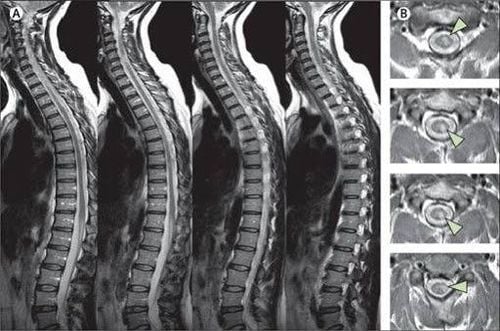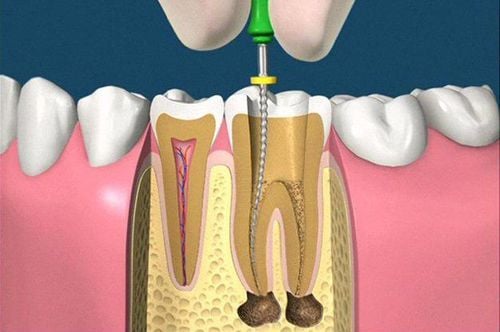This is an automatically translated article.
Articles written by MSc, BS. Nguyen Thi Minh Phuong, Department of General Internal Medicine - Vinmec Times City International General Hospital
Transverse myelitis is common between the ages of 10-19 years old and 30-39 years old, causing damage or destruction of myelin, causing nerve cells to lose the ability to transmit nerve information from the spinal cord to organs in the body. body.
1. What is Transverse myelitis?
Transverse myelitis is an inflammatory process of one or more consecutive segments of the pulp, usually the thoracic cord. Inflammation causes destruction or damage to myelin, a lipid-rich substance that surrounds nerve cell axons. When myelin is damaged, nerve cells lose their ability to transmit nerve messages (action potentials) from the spinal cord to the rest of the body, causing sensory and motor symptoms. or circular muscle disorder.
Transverse myelitis can occur at any age, both male and female, as well as in different races. However, the disease is most common in the age group of 10-19 years old and 30-39 years old.
2. Causes of transverse myelitis
There are many causes of cross-sectional myelitis:
Autoimmune inflammatory diseases of the central nervous system: multiple sclerosis, neuromyelitis optica disorders, acute diffuse encephalomyelitis. Systemic inflammatory and autoimmune disorders: ankylosing spondylitis, Sjogren's syndrome, systemic lupus erythematosus, sarcoidosis, Behcet's disease. Infectious causes: caused by bacteria, viruses, parasites, fungi. Paraneoplastic syndromes and cancer. Cases where the above causes cannot be found or demonstrated are called idiopathic transverse myelitis.

Bệnh lý lupus ban đỏ hệ thống là một trong các nguyên nhân gây viêm tủy cắt ngang
3. Idiopathic transverse myelitis
Idiopathic transverse myelitis can be acute (within hours to days), or subacute (days to 4 weeks).
Symptoms of idiopathic transverse myelitis include:
Motor symptoms: rapid progression of weakness in one or both legs, which can cause complete paralysis of both legs, making the patient unable to walk. If the injury occurs in the cervical spinal cord, the patient may be paralyzed in both arms. Sensory symptoms: increased pain sensation to the touch, light touch to the skin. Numbness or pins-and-needles sensation in the limbs and trunk below the damaged pulp. The patient may experience frostbite, or complete loss of sensation in the legs. Sometimes there is a sharp pain along the spine when lowering the head and disappearing when the head is tilted back to normal position, called Lhermittes sign. Pain: Back pain symptoms can appear from the beginning, or pain spreads from the back to the legs, from the neck to the hands. Bladder-intestinal dysfunction: possible urinary retention, constipation, or increased feeling of inability to urinate, frequent urination. In addition, many patients may experience discomfort, fever, muscle stiffness, loss of appetite, or even difficulty breathing.
4. Diagnosis of idiopathic transverse myelitis
To diagnose idiopathic transverse myelitis, it is necessary to exclude causes such as autoimmune diseases, infectious diseases, and paraneoplastic diseases.
The patient will have tests such as:
MRI (magnetic resonance) of the cervical or thoracic spine, brain MRI with contrast injection; Cerebrospinal fluid puncture; Blood tests to rule out autoimmune, paracancerous, and infectious causes; In some cases, initial MRI and lumbar puncture are normal, but may have to be repeated after 5-7 days.

Viêm tủy cắt ngang cần được thực hiện phương pháp chụp MRI giúp chẩn đoán viêm tủy cắt ngang vô căn
5. Treatment of idiopathic transverse myelitis
High-dose Corticosteroids: The use of high-dose corticosteroids for 3-5 days will reduce inflammation and pulp edema. Should start as soon as possible. The drugs most commonly used are intravenous methylprednisolone or dexamethasone.
Plasmapheresis: if the patient responds poorly to corticosteroids, plasmapheresis can be performed. Normally will filter every other day in a 10-day period. The current trend is to start hemodialysis early if the patient has severe symptoms of limb paralysis, not until corticosteroids are effective.
For patients with recurrent idiopathic transverse myelitis, an immunomodulatory drug such as Mycophenolate or Rituximab can be combined.
6. Prognosis
Most patients with idiopathic transverse myelitis will recover at least partially from their symptoms. Recovery can take 1 to 3 months, or longer. Patients need to continue to practice rehabilitation. About 40% of patients may have partial sequelae. If the initial symptoms occur quickly, accompanied by complete paralysis of both legs, the prognosis for recovery will be poor.
Most patients with idiopathic transverse myelitis have only one episode. Approximately 25-33% of patients will experience a relapse.
In order for the treatment to be effective, detecting the disease has a very important role. Therefore, when the body shows strange symptoms, you should immediately go to a reputable medical facility for examination. Vinmec International General Hospital is a high-quality medical facility in Vietnam with a team of highly qualified medical professionals, well-trained, domestic and foreign, and experienced.
A system of modern and advanced medical equipment, possessing many of the best machines in the world, helping to detect many difficult and dangerous diseases in a short time, supporting the diagnosis and treatment of doctors the most effective. The hospital space is designed according to 5-star hotel standards, giving patients comfort, friendliness and peace of mind.
Please dial HOTLINE for more information or register for an appointment HERE. Download MyVinmec app to make appointments faster and to manage your bookings easily.













